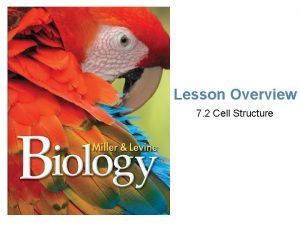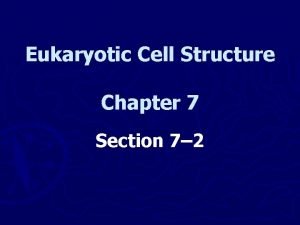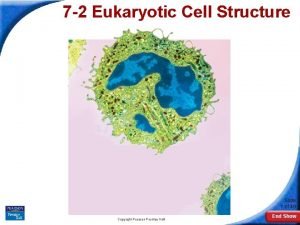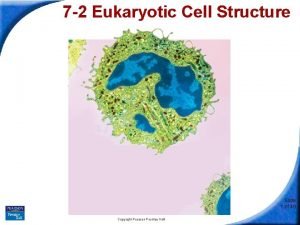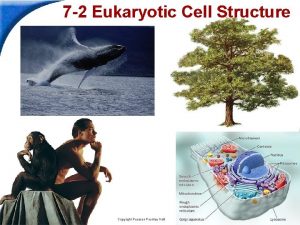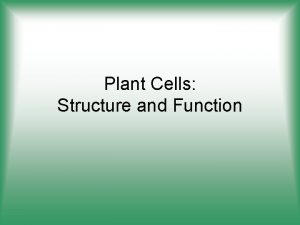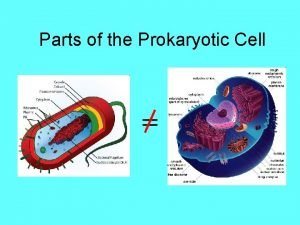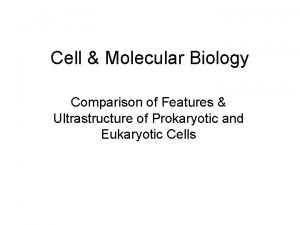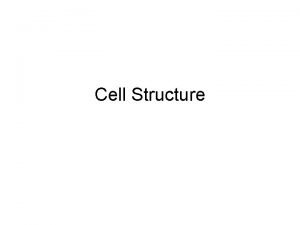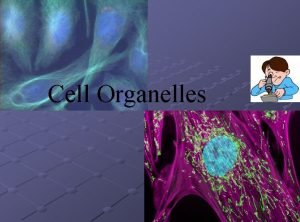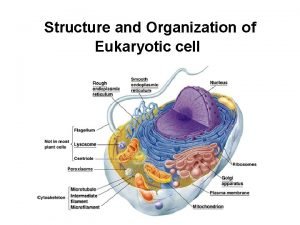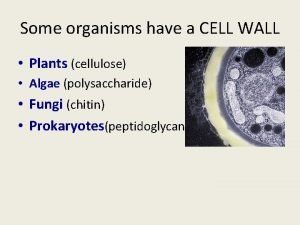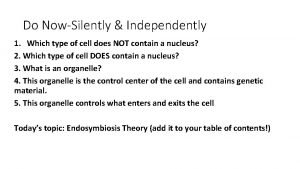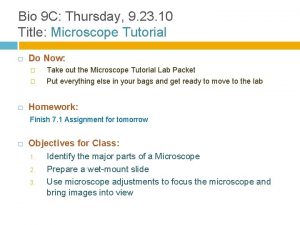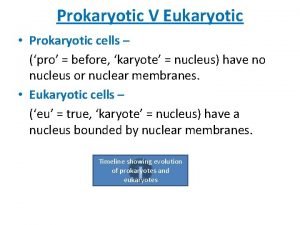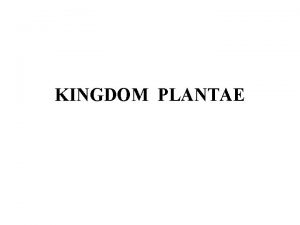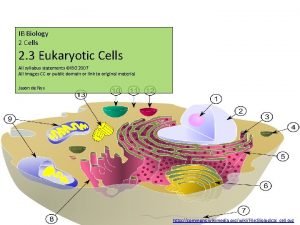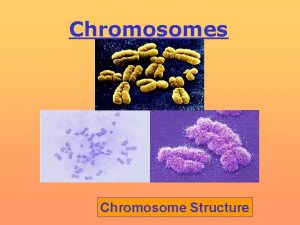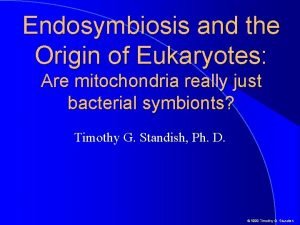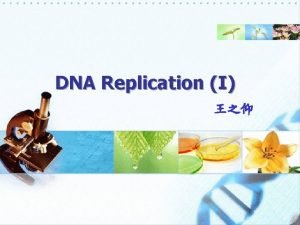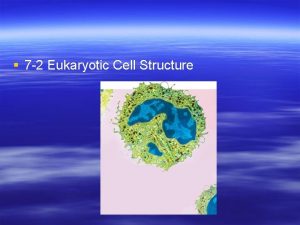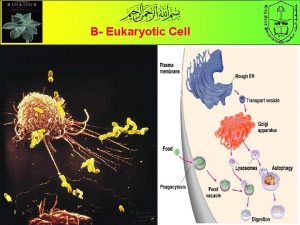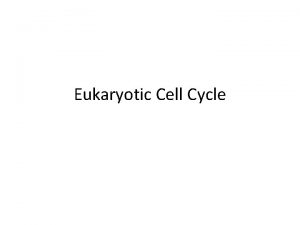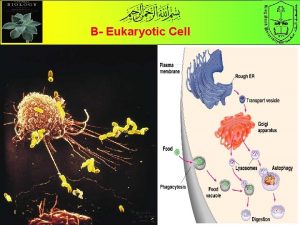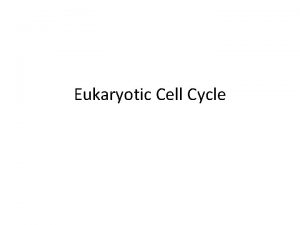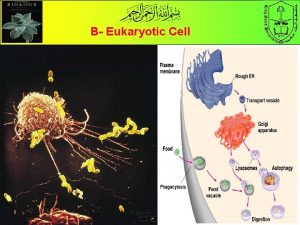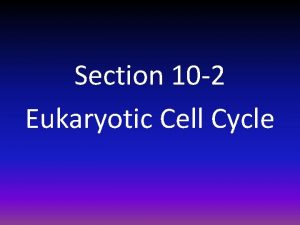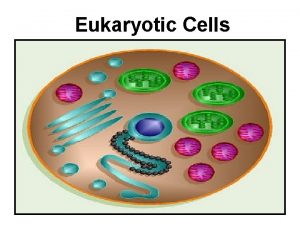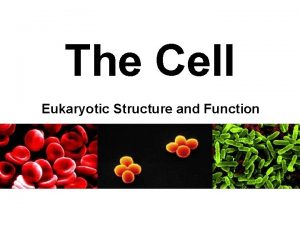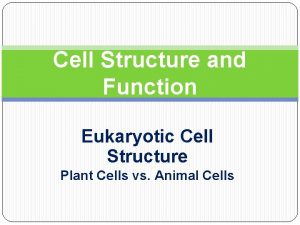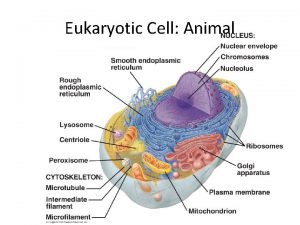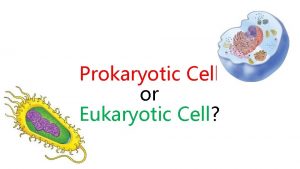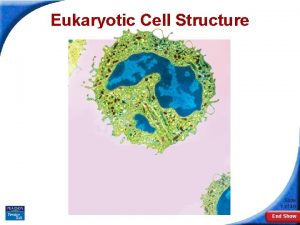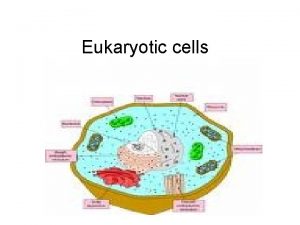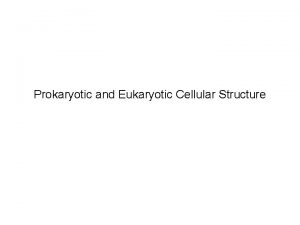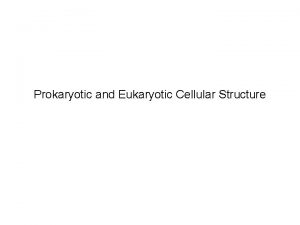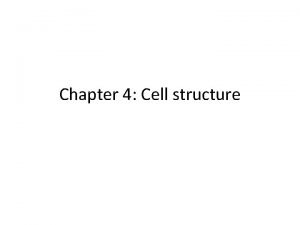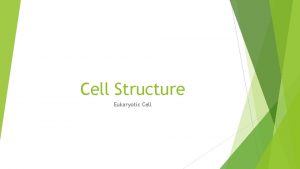7 2 Eukaryotic Cell Structure Slide 1 of








































- Slides: 40

7 -2 Eukaryotic Cell Structure Slide 1 of 49 Copyright Pearson Prentice Hall

7 -2 Eukaryotic Cell Structure Comparing the Cell to a Factory o. Eukaryotic Cell Structures o. Structures within a eukaryotic cell that perform important cellular functions are known as ____________. o. Cell biologists divide the eukaryotic cell into two major parts: o. The _______: Houses cell’s DNA o. The _______ o. The ______is the portion of the cell outside the nucleus. Site of most of the cells _____. Slide 2 of 49 Copyright Pearson Prentice Hall

7 -2 Eukaryotic Cell Structure Comparing the Cell to a Factory Plant Cell Nucleolus Nucleus Smooth endoplasmic reticulum Nuclear envelope Ribosome (free) Rough endoplasmic reticulum Ribosome (attached) Golgi apparatus Cell wall Cell membrane Chloroplast Mitochondrion Vacuole Slide 3 of 49 Copyright Pearson Prentice Hall

7 -2 Eukaryotic Cell Structure Comparing the Cell to a Factory Animal Cell Nucleolus Nucleus Smooth endoplasmic reticulum Ribosome (free) Nuclear envelope Cell membrane Rough endoplasmic reticulum Ribosome (attached) Centrioles Golgi apparatus Mitochondrion Slide 4 of 49 Copyright Pearson Prentice Hall

7 -2 Eukaryotic Cell Structure Nucleus o. The ______is the _______ of the cell. o. The nucleus contains nearly all the cell's _____and with it the coded instructions for ________ and other important molecules. Slide 5 of 49 Copyright Pearson Prentice Hall

7 -2 Eukaryotic Cell Structure Nucleus The Nucleus Chromatin Nuclear envelope Nucleolus Nuclear pores Slide 6 of 49 Copyright Pearson Prentice Hall

7 -2 Eukaryotic Cell Structure Nucleus o. The nucleus is surrounded by a _________ composed of two membranes. o. The envelope is dotted with __________, which allow material to move Nuclear in and out of the envelope nucleus. Copyright Pearson Prentice Hall Nuclear pores Slide 7 of 49

7 -2 Eukaryotic Cell Structure Nucleus o. The granular material in the nucleus is called ________. o. Chromatin consists of ____________. Chromatin Slide 8 of 49 Copyright Pearson Prentice Hall

7 -2 Eukaryotic Cell Structure Nucleus o. When a cell divides, chromatin condenses to form __________. o________contain the ________ that is passed from one generation of cells to the next. Slide 9 of 49 Copyright Pearson Prentice Hall

7 -2 Eukaryotic Cell Structure Nucleus o. Most nuclei also contain a _________. o. The nucleolus is where the _______begins. Nucleolus o. Nucleus Review Slide 10 of 49 Copyright Pearson Prentice Hall

7 -2 Eukaryotic Cell Structure Ribosomes o. One of the most important jobs carried out in the cell is making proteins. o. Proteins are assembled on ______. o_______are small particles of RNA and protein found throughout the cytoplasm. Slide 11 of 49 Copyright Pearson Prentice Hall

7 -2 Eukaryotic Cell Structure Ribosomes o. Ribosomes produce proteins by following ___________ that come from the ______. o. Cells that are active in protein synthesis are often packed with ribosomes. o ________________ Slide 12 of 49 Copyright Pearson Prentice Hall

7 -2 Eukaryotic Cell Structure Endoplasmic Reticulum o. Eukaryotic cells contain an internal membrane system called the______________. o. The endoplasmic reticulum is where _________________, along with ________________________f rom the cell. Slide 13 of 49 Copyright Pearson Prentice Hall

7 -2 Eukaryotic Cell Structure Endoplasmic Reticulum Ribosomes Slide 14 of 49 Copyright Pearson Prentice Hall

7 -2 Eukaryotic Cell Structure Endoplasmic Reticulum o. There are two types of ___________. o. The portion of the ER involved in _______ is called __________________. o________are found on the surface of rough ER. o. Rough ER is abundant in cells that produce _______________________. Slide 15 of 49 Copyright Pearson Prentice Hall

7 -2 Eukaryotic Cell Structure Endoplasmic Reticulum o_______________on its surface. o________ contains collections of enzymes that perform specialized tasks, such as __________________________. Slide 16 of 49 Copyright Pearson Prentice Hall

7 -2 Eukaryotic Cell Structure Golgi Apparatus o. Proteins produced in the rough ER move into the _________. Slide 17 of 49 Copyright Pearson Prentice Hall

7 -2 Eukaryotic Cell Structure Golgi Apparatus o. The Golgi apparatus appears as a ____________________________. Slide 18 of 49 Copyright Pearson Prentice Hall

7 -2 Eukaryotic Cell Structure Golgi Apparatus o. The Golgi apparatus _______________________________for storage in the cell or secretion outside the cell. o. From the Golgi apparatus, proteins are then “____” to their final destinations throughout the cell or outside of the cell. o. Video review Slide 19 of 49 Copyright Pearson Prentice Hall

7 -2 Eukaryotic Cell Structure Lysosomes o________ are small organelles filled with enzymes. o. Lysosomes ______________________________that can be used by the rest of the cell. o. Lysosomes also _________________________________. Slide 20 of 49 Copyright Pearson Prentice Hall

7 -2 Eukaryotic Cell Structure Vacuoles o. Some cells contain saclike structures called ________ that _______________________________. Slide 21 of 49 Copyright Pearson Prentice Hall

7 -2 Eukaryotic Cell Structure Vacuoles o. In many plant cells there is a single, large _____________ filled with liquid. o. The _______________allows plants to support heavy structures such as leaves and flowers. Vacuole Slide 22 of 49 Copyright Pearson Prentice Hall

7 -2 Eukaryotic Cell Structure o. Vacuoles are also found in some unicellular organisms and in some animals. Vacuoles Contractile vacuole o. The paramecium contains a ____________that ____________________. Slide 23 of 49 Copyright Pearson Prentice Hall

7 -2 Eukaryotic Cell Structure Mitochondria and Chloroplasts o. Mitochondria o. Nearly all eukaryotic cells contain _________. o. Mitochondria convert the chemical energy stored in food ___________________ __________ Mitochondrion Slide 24 of 49 Copyright Pearson Prentice Hall

7 -2 Eukaryotic Cell Structure Mitochondria and Chloroplasts o. Mitochondria are enclosed by two membranes—an _____________________. o. The inner membrane (_____) is ______ inside the organelle. Slide 25 of 49 Copyright Pearson Prentice Hall

7 -2 Eukaryotic Cell Structure o. Chloroplasts Mitochondria and Chloroplasts Chloroplast o. Plants and some other organisms contain______. o. Chloroplasts capture energy from sunlight and convert it into chemical energy in a process called _________. Slide 26 of 49 Copyright Pearson Prentice Hall

7 -2 Eukaryotic Cell Structure Mitochondria and Chloroplasts o. Chloroplasts are surrounded by ________. o. Chloroplasts contain the green pigment _________. Slide 27 of 49 Copyright Pearson Prentice Hall

7 -2 Eukaryotic Cell Structure Cytoskeleton o. Eukaryotic cells are given their shape and internal organization by the _________. Slide 28 of 49 Copyright Pearson Prentice Hall

7 -2 Eukaryotic Cell Structure Cytoskeleton The cytoskeleton is a network of protein filaments that helps the cell to_______. The cytoskeleton is also involved in ________. The cytoskeleton is made up of: • ___________________ Slide 29 of 49 Copyright Pearson Prentice Hall

7 -2 Eukaryotic Cell Structure Cytoskeleton Cell membrane Endoplasmic reticulum Microtubule Microfilament Ribosomes Mitochondrion Copyright Pearson Prentice Hall Slide 30 of 49

7 -2 Eukaryotic Cell Structure Cytoskeleton Microfilaments: • are threadlike structures made up of the protein ______. • form extensive networks in some cells. • _________________ that supports the cell. • _______________. Slide 31 of 49 Copyright Pearson Prentice Hall

7 -2 Eukaryotic Cell Structure Cytoskeleton Microtubules ___________ are hollow structures made up of proteins known as tubulins. Microtubules: • Maintain_________. • are important in ___________. • build projections from the cell ____________________ —that enable some cells to swim rapidly through liquids. Slide 32 of 49 Copyright Pearson Prentice Hall

7 -2 Eukaryotic Cell Structure Cytoskeleton o. In animal cells, structures known as ______ are formed from tubulin. o_________ are located near the nucleus and help to organize cell division. Slide 33 of 49 Copyright Pearson Prentice Hall

7 -2 Click to Launch: Continue to: - or - Slide 34 of 49 Copyright Pearson Prentice Hall

7 -2 In the nucleus of a cell, the DNA is usually visible as a. a dense region called the nucleolus. b. the nuclear envelope. c. granular material called chromatin. d. condensed bodies called chloroplasts. Slide 35 of 49 Copyright Pearson Prentice Hall

7 -2 Two functions of vacuoles are storing materials and helping to a. break down organelles. b. assemble proteins. c. maintain homeostasis. d. make new organelles. Slide 36 of 49 Copyright Pearson Prentice Hall

7 -2 Chloroplasts are found in the cells of a. plants only. b. plants and some other organisms. c. all eukaryotes. d. most prokaryotes. Slide 37 of 49 Copyright Pearson Prentice Hall

7 -2 Which of the following is NOT a function of the Golgi apparatus? a. synthesize proteins b. modify proteins c. sort proteins d. package proteins Slide 38 of 49 Copyright Pearson Prentice Hall

7 -2 Which of the following is a function of the cytoskeleton? a. manufactures new cell organelles b. assists in movement of some cells from one place to another c. releases energy in cells d. modifies, sorts, and packages proteins Slide 39 of 49 Copyright Pearson Prentice Hall

END OF SECTION
 Site:slidetodoc.com
Site:slidetodoc.com Linear chromosomes in eukaryotes
Linear chromosomes in eukaryotes Life
Life Carbohydrate side chain
Carbohydrate side chain Eucariote
Eucariote Cell structure
Cell structure Distinct threadlike structures contain genetic
Distinct threadlike structures contain genetic Biology chapter 7 cell structure and function
Biology chapter 7 cell structure and function 7-2 eukaryotic cell structure
7-2 eukaryotic cell structure Section 7-2 eukaryotic cell structure
Section 7-2 eukaryotic cell structure Section 7-2 eukaryotic cell structure
Section 7-2 eukaryotic cell structure Eukaryotic plant
Eukaryotic plant Heel toe polka dance steps
Heel toe polka dance steps Amoeba prokaryotic or eukaryotic
Amoeba prokaryotic or eukaryotic Typical eukaryotic cell
Typical eukaryotic cell Eukaryotic cell organisation
Eukaryotic cell organisation Differences between prokaryotic and eukaryotic
Differences between prokaryotic and eukaryotic Eukaryotic cells
Eukaryotic cells Lipshutz bodies
Lipshutz bodies Are cell walls prokaryotic or eukaryotic
Are cell walls prokaryotic or eukaryotic Are plants multicellular eukaryotes
Are plants multicellular eukaryotes Eukaryotic cell questions
Eukaryotic cell questions Organelle speed dating
Organelle speed dating Prokaryotic and eukaryotic difference
Prokaryotic and eukaryotic difference Algae classification
Algae classification Ib biology eukaryotic cell diagram
Ib biology eukaryotic cell diagram Prokaryotic vs eukaryotic cells
Prokaryotic vs eukaryotic cells How to read chromosome
How to read chromosome What happens in telophase
What happens in telophase Eukaryotic chromosome structure
Eukaryotic chromosome structure Eukaryotic chromosome structure
Eukaryotic chromosome structure Factoring slide and divide
Factoring slide and divide Cell city project animal cell
Cell city project animal cell Advantages and disadvantages of diaphragm cell process
Advantages and disadvantages of diaphragm cell process Plant and animal cell venn diagram
Plant and animal cell venn diagram Electrode concentration cell
Electrode concentration cell Dry cell vs wet cell
Dry cell vs wet cell Animal cell venn diagram
Animal cell venn diagram Cell wall function
Cell wall function Tonoplast
Tonoplast Structure of a plant cell
Structure of a plant cell





